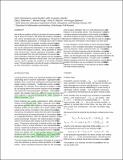| dc.contributor.author | Poliannikov, Oleg V. | |
| dc.contributor.author | Prange, Michael | |
| dc.contributor.author | Malcolm, Alison E. | |
| dc.contributor.author | Djikpesse, Hugues | |
| dc.contributor.other | Massachusetts Institute of Technology. Earth Resources Laboratory | |
| dc.date.accessioned | 2014-10-02T14:09:00Z | |
| dc.date.available | 2014-10-02T14:09:00Z | |
| dc.date.issued | 2013 | |
| dc.identifier.uri | http://hdl.handle.net/1721.1/90522 | |
| dc.description.abstract | We study the problem of the joint location of seismic events using an array of receivers. We show that locating multiple seismic events simultaneously is advantageous compared to the more traditional approaches of locating each event independently. Joint location, by design, includes estimating an uncertainty distribution on the absolute position of the events. From this can be deduced the distribution on the relative position of one event with respect to others. Many quantities of interest, such as fault sizes, fracture spacing or orientation, can be directly estimated from the joint distribution of seismic events. Event relocation methods usually update only the target event, while keeping the reference events fixed. Our joint approach can be used to update the locations of all events simultaneously. The joint approach can also be used in a Bayesian sense as prior information in locating a new event. | en_US |
| dc.description.sponsorship | Massachusetts Institute of Technology. Earth Resources Laboratory (Founding Members Consortium); National Science Foundation (U.S.) (Grant SES-0962484) | en_US |
| dc.language.iso | en_US | en_US |
| dc.publisher | Massachusetts Institute of Technology. Earth Resources Laboratory | en_US |
| dc.relation.ispartofseries | Earth Resources Laboratory Industry Consortia Annual Report;2013-16 | |
| dc.subject | Inversion | |
| dc.subject | Microseismic | |
| dc.title | Joint microseismic event location with uncertain velocity | en_US |
| dc.type | Technical Report | en_US |
